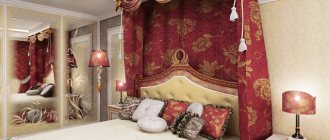Japanese style bedroom interior
Pay close attention to lighting. The bedroom is a place for privacy and relaxation, which means there is no place for excess light. If this room is used as a living room, then it is worth thinking about separate lighting, implemented using a switch.
As for furniture, it should be functional, but at the same time not pretentious and simple. Since the Japanese sleep on the floor on small mattresses (futons), this is reflected in modern design. Low beds without legs fit perfectly into the interior. Several bedside tables and a small closet - what else is needed for a comfortable life? It is worth noting that the furniture should be as simple in shape as possible and made of natural wood.
Designers, trying to accurately recreate a Japanese-style bedroom in Russian apartments, resort to installing a special structure - a platform into which the mattress is placed. Visually, it turns out that the bed is on the floor. Our review with reviews will help you choose the right bed model from a variety of options:.
If all design is subject to the strict use of only natural materials, then this also applies to the choice of curtains. They perform the protective function of the room, hiding secluded corners from prying eyes at any time of the day. Curtains should be light-proof, but consistent with the overall design and be in the same color scheme as the walls and ceiling.
Features of Japanese style
The Japanese design direction is fundamentally different from all other Eastern and European interior genres. It is based on a very strict and ascetic philosophy of life, which is reflected in non-standard planning solutions.
The Asian-style interior is focused on minimalism and the desire for unity with nature, so both excessive pretentiousness and excessive luxury are alien to it. The main focus is on creating the most open and functional space with a minimum amount of furniture and various household items.
Character traits
As a rule, Japanese motifs in the interior are easily discernible at first glance. Firstly, they are characterized by maximum restraint and simplicity, and secondly, by the complete absence of artificial, synthetic materials. Other important “ingredients” of the style include the obligatory use of a slightly muted color palette and special thematic decor.
It is noteworthy that in traditional Japanese houses there are almost always no internal main walls. This is due not only to the special geographical location of the country, which contributes to fairly frequent natural disasters, but also to the special worldview of the Japanese, based on the desire to understand themselves and get as close as possible to nature.
Functional zoning of living rooms is usually carried out using multi-level floors and ceilings. Screens and partitions with wooden or bamboo slats are also very often used. If necessary, such structures can be easily folded and moved, allowing the space to be reorganized quite often with a minimum of effort.
Color spectrum
The main color palette is quite restrained.
The main dominant tones are most often warm and neutral natural colors:
- white;
- cream;
- beige;
- sand.
When finishing walls and ceiling surfaces, it is preferable to use light sand or light fawn shades, but when covering the floor, you can give preference to darker and richer brownish-coffee tones.
Among the accent shades, small splashes of sunny yellow and slightly muted scarlet color predominate, but the use of any too bright and saturated tones should be strictly limited.
Finishing walls, ceilings and floors
When decorating a home, materials of exclusively natural origin are almost always used. As an exception, it is allowed to use high-quality imitation. For example, instead of expensive wood, you can put a more budget-friendly laminate on the floor with an expressive textured wood pattern, and in the so-called “wet areas” (in the bathroom and toilet) “wood-like” porcelain stoneware or ceramic tiles will look harmonious.
To cover the walls, it is advisable to use wallpaper made of bamboo or paper, although some other options are also allowed (for example, painting with light matte paint or facing with wooden rectangular panels). If desired, one of the walls can be highlighted with beautiful photo wallpapers depicting bamboo thickets or Mount Fuji.
The ceiling surface is never too elaborate or complex. The most suitable option is to use simple tension structures painted to match the walls.
Another great idea is to use a matte stretch ceiling with wooden square frames. The latter method is considered more interesting, especially if you complement it with not too bright built-in lighting and small rectangular frosted glass inserts.
Furniture
Typical Japanese furniture is almost always characterized by a special design. First of all, it is distinguished by its very compact size and almost complete absence of decor. Due to the peculiarities of the local landscape and frequent natural disasters, residents of the Land of the Rising Sun have not used overly bulky furniture installations in their homes for a long time.
Typically, all cabinets, tables and beds are made from local wood species, such as:
- cedar;
- maple;
- oak;
- beech
The more expensive wood of mahogany, dark walnut or black ash is used somewhat less frequently.
A Japanese-style bed is almost always as low and wide as possible. It is not characterized by elaborate decorative carvings and forging elements.
The dining table must have a strict rectangular shape and low wooden legs. Instead of chairs, small, laconic stools with soft seats or decorative pillows made from natural plain fabrics are often used.
Decor and curtains
As mentioned above, a traditional Asian interior is characterized by a small number of decorative elements. The walls are usually decorated with simple and laconic paintings depicting various birds, animals and landscapes.
Laconic porcelain or ceramic vases with blooming orchids or sakura are often installed on open niches and shelves. It is not forbidden to decorate the interior with suitable indoor plants, for example, an elegant bonsai tree or unpretentious ficus. To create a special coziness, you can lay out traditional Japanese mats or soft, plain carpets on the floor.
Additional decorative elements may also include:
- paper or silk folding fans with characteristic national motifs;
- antique samurai swords;
- reproductions of famous prints (for example, Furuyama Moromasa, Torii Kiyomoto, Ando Kaigetsudo).
The textile framing of the window is most often provided by laconic panel curtains, which are essentially simple sliding structures with two absolutely flat sheets of fabric. They move easily along a special multi-layer cornice, thanks to which wrinkles never form on the curtains.
Unlike many European models, panel curtains are completely devoid of decor. Their priority is to gently diffuse light and create a pleasant, slightly shaded atmosphere. According to centuries-old traditions, such curtains are made exclusively from natural fabrics or bamboo, rattan, jute, and hemp.
It is important to note that the modern interpretation of the style allows for some experimentation. For example, various combinations of light fabrics combined with heavier textured materials look very original and beautiful. As for the color scheme, slightly muted, discreet colors from a natural palette are most appropriate.
Lighting and windows
To create a beautiful and charming interior, you need as much natural daylight as possible. Abundant natural light is created by large windows, which, according to established traditions, are never covered with either light flowing tulle curtains or too thick curtains.
It should be noted that large windows not only allow natural daylight to pass through as efficiently as possible, but also provide very close visual contact with nature, especially if the oriental interior is designed in a private country house. During the daytime, such a room will be flooded with bright sunlight, giving a feeling of boundless unity with nature.
By the way, window openings should, if possible, be chosen from natural wood, and not from plastic imitating it.
As for artificial lighting fixtures, they are characterized by simple and laconic geometric shapes combined with very restrained color and decorative design.
The room and its features
A Japanese-style bedroom today is not the traditional design of Asian homes. Everything there is too simple and even ascetic. Instead of a bed there is a mattress, which is put away in a closet during the day, chairs are replaced with tatami, and the tables even look like toys - low and small.
The modern design of a Japanese bedroom is just an imitation of traditions, adding oriental flavor to comfortable European housing.
The good thing about Japanese style is that it can be applied to any room. The design can fit equally harmoniously into a small room in a city apartment, or into a spacious room in a country house. Neither the area of the bedroom, nor the height of the ceilings, nor the number of windows play a big role in creating a Japanese flavor.
All the designer needs in this case is light and space. Therefore, it is better to choose a room with good lighting for a Japanese bedroom. But the space can be expanded using artificial methods.
Another important point is natural materials. Japanese style should contain as few artificial things as possible. Wood, paper, bamboo, cotton, silk, frosted glass are welcome. In general, all surfaces should be matte, preferably rough. Gloss and shine are not inherent in the Japanese style; texture and depth are valued here.
Japanese style bedroom design: important points
Eastern philosophy is aimed at the unity of the soul with nature. This is precisely what underlies Japanese minimalism, which is actively being introduced into the interior. Just a few basic shades, simple and uncomplicated shapes and natural materials - this is how this design direction can be briefly described.
In order to decorate a bedroom in a traditional Japanese style, you need to truly love the culture of this country. When decorating a room with your own hands, you don’t need to rely only on photos; it is important to take into account some rules.
For features and main directions of oriental style, see the material:.
The main aspects that characterize the Japanese style in the bedroom:
- The eastern direction is based on minimalism. It manifests itself in color combinations, the use of furniture, and the use of accessories. Negative energy accumulating in the room will be retained in it due to the large number of objects. Therefore, avoid clutter in the room.
- Bedroom functionality. It is necessary to correctly fit furniture into the room (bed, wardrobe, mirror, bedside tables - this is the minimum necessary) so that the space is not cluttered. If it is not possible to organically place what you want, the design turns out to be overloaded and, as a result, the first point on the list is violated.
- Harmony with nature. The priority is to use only natural materials. On a subconscious level, natural shades and textures contribute to complete unity with soul and body.
- Quick transformation of the room. As you know, Japanese houses have a unique feature: they, like houses of cards, consist of panels that can be easily rearranged to another location. In fact, one room can turn into several others. This is the principle that should be followed in city apartments.
As for the last point, there can be no talk of dramatic changes in space, as in Japanese houses. But there is a wonderful alternative - the use of retractable interior doors or partitions. They are used for zoning space and perfectly delimit the room.
No colorful flowers in a Japanese-style room. Bright and flashy shades negatively affect a person’s well-being, preventing them from truly relaxing and enjoying the peace in the room. Only gentle, calm, pastel colors. See a review of bedrooms in pastel colors here:.
Japanese-style bedroom: decoration recommendations with visual photos
Any room design involves external decoration of three components: floor, walls and ceiling. The right combination of materials and colors allows you to make the interior unique and unique, taking into account the chosen style.
When decorating a room, adhere to the following rules:
- The floor should be made of wood. In the event that financial resources do not allow the use of natural materials, linoleum with imitation wood is suitable.
- The walls are made airy and light by installing rice paper curtains. In real life, it is not possible to use such materials due to the operational qualities of apartments (temperature changes), so they are perfectly replaced by photo wallpapers depicting bamboo or wooden panels. A modern solution is to cover the walls with a plain fabric.
- The ceiling must be perfectly flat and smooth. This effect can be achieved using stretch ceilings. Modern technologies allow you to apply an image to the canvas. In particular, a suspended ceiling with a photo corresponding to an oriental theme is suitable for the bedroom in order to recreate the interior in the bedroom to the maximum.
If you follow all the above conditions, then using the right accessories and pieces of furniture you will get a very romantic bedroom in which two loving hearts will never be bored.
To avoid cluttering the room with cabinets, purchase a small bedside table. Personal belongings will be conveniently located on it, and it will not get in the way under your feet.











